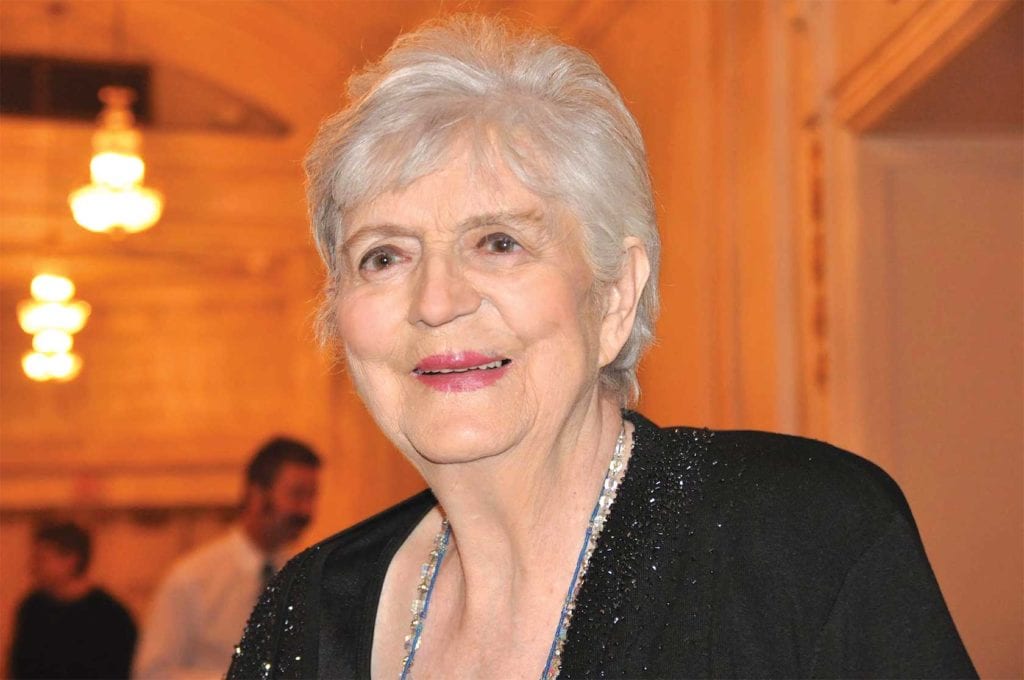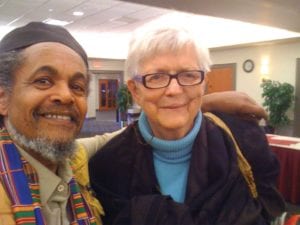
Kay Bourne PHOTO: COURTESY KATIE BOURNE
Kay Bourne, who served as the Banner’s arts editor through the paper’s first four decades, passed away Sunday, Jan. 31. She was 82.
While writing for the Banner, Bourne took a keen interest in Boston’s Black arts community, highlighting the contributions of local visual artists, playwrights, musicians and actors, while at the same time covering national and international stars who made stops in the city.
She covered the luminaries of the community with sensitivity and respect, helping generations of artists gain recognition and reach broader audiences.

Napoleon Jones-Henderson and Kay Bourne PHOTO: COURTESY NAPOLEON JONES-HENDERSON
Katherine Day was born in 1938 and grew up in Marblehead, graduating from high school there. She graduated in 1960 from Keene Teachers College, where she met her husband, William N. Bourne.
She joined the staff of the Bay State Banner in 1966, the year after the paper was founded, and lost no time delving into the Black community’s arts scene.
“She was one of those people who just showed everybody love,” said political activist Jamarhl Crawford, a poet and emcee whose work Bourne highlighted.
Crawford noted that Bourne’s coverage of the arts scene in the ‘60s captured much of the energy of the Black Arts Movement that fed the rise of institutions such as the Elma Lewis School.
“Boston was a destination for arts and culture,” he said. “Kay Bourne covered all segments of the arts.”
While Boston audiences always drew famous Black performers, Bourne trained her eye on local talent from the beginning of her tenure at the Banner, showing a particular fondness for the fine arts, as Roxbury-based artist Ekua Holmes recalls.
“Kay was the first person to print ink about my art, and an early collector,” Holmes said. “For the community of Black artists — painters, dancers, actors, writers — she showed up for us, invested in us, pursued us, told our stories and remembered them to us. While for other elements of the press we were invisible, to Kay we were center stage.”
In addition to reviewing their work, Bourne collected work from local artists. She would often conduct interviews with visual artists in her Brookline home, the walls of which were decorated with the works of their peers.
She showed an equal measure of enthusiasm for the work of local poets, singers, dancers and musicians. Her reviews and interviews with Roxbury jazz luminaries captured the unique and remarkable characteristics of their musical styles.
“Roy is a clean drummer,” she wrote of Roxbury-born drummer Roy Haynes in a 1977 review of a gig he played at the Cambridge nightclub Rise. “He is a driver; he wore the tenor player out, who fortunately has remarkable recuperative powers. He is a leader; he really directed the band causing different inflections and excitement. Audiences are truly fortunate that Roy plays clubs because something magical happens with him on an intimate stage. The force of his playing creates a zoom shot in the mind that would appear false or forced if it were recreated for film; one minute Roy is a musician with other musicians and the next minute he gets closer and closer, it seems, until he and his drums are what are before the eyes.”
Beyond her passion for the arts, Bourne maintained a commitment to education. She established and taught a GED preparation course for inmates at the Deer Island House of Correction.
Bourne donated her file cabinets of papers and memorabilia from Boston’s Black arts scene to Emerson College, which now maintains the Kay Bourne Archives. She also donated her collection of African American literature to UMass Dartmouth.
As news of Bourne’s passing made its way through the arts community, messages of appreciation collected on her Facebook page. Reached by phone, artists shared with the Banner stories of Bourne’s dedication to Boston’s Black artists.
“Anybody who’s anybody in the arts — all of us owe her a debt for respect for her making sure our work was a part of the cultural archive,” artist Napoleon Jones-Henderson said. “She definitely made an impression and imprint on all the artists who had her in their lives in Boston.”
Bourne is survived by her daughter Katie, her son Alex and two grandchildren. The family plans to hold a memorial service after pandemic restrictions are lifted on public gatherings.


:strip_icc()/BHG_PTSN19720-33d9cd22f6ab49e6a21982e451321898.jpg)

More Stories
Fresh and Airy Interior Design Living Room Ideas for Summer
Where Art and Sound Converge: Exploring Fine Art Photography and Music Artist Portraiture
Cooking Chinese Cuisine with Ease Using Jackery Solar Generator 5000 Plus